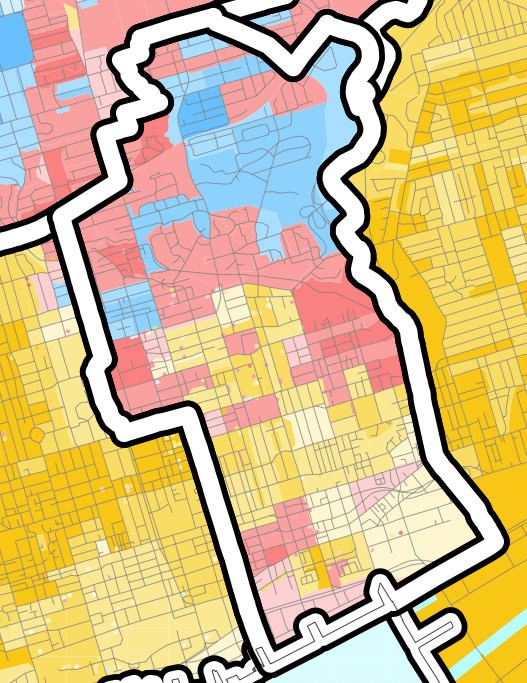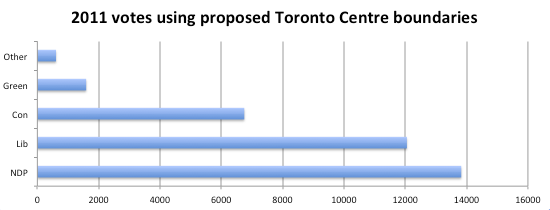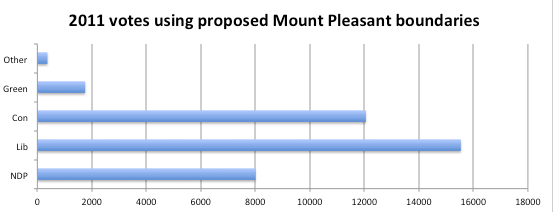
The voters of Toronto Centre have always felt divided. The federal riding includes some of the richest (Rosedale, Yorkville ) and poorest (St. James Town, Regent Park) neighbourhoods in the country. At an all candidates meeting in St. James Town during a recent election one audience member accusingly asked if any candidates lived “south of Bloor,” in other words, if they could identify with and represent him. Likewise, some Rosedale residents have lamented that they can never get the representative they really want because they’re out-voted by their less affluent and more left-leaning neighbours to the south.
As a result, centrist Liberals have comfortably held the riding since 1993. (Before that it was held by the most Progressive of Conservatives, namely David MacDonald, who later joined the NDP, and David Crombie. Before them, more Liberals.) The north half of the riding has always been a Liberal-Conservative contest and the south half a Liberal-NDP one. As the only party with significant support throughout the riding, Liberals take it every time.
Now, that could change. The Federal Electoral Boundaries Commission has proposed new boundaries that would split the riding in two. If adopted after a period of consultation, the south half of the riding will absorb some of Trinity-Spadina to the west and become the new Toronto Centre. The north half of the riding is to acquire the north-east portion of the current St. Pauls to become the new riding of Mount Pleasant. And the Liberals are in serious danger of losing both.
The new Toronto Centre
In fact, I think they might as well kiss the new southern riding of Toronto Centre goodbye. In 2011, that half of the riding favoured the NDP candidate over the Liberal by 3%. Add in the votes from the section of Trinity-Spadina that’s to move over and the NDP margin increases to 5%, or 1,700 votes.

That may not sound like an orange nail in the red coffin, but keep in mind the NDP earned that much support in the current Toronto Centre without any reasonable prospect of winning. With these improved odds will come a more high-profile candidate, more motivated voters and volunteers, and increased money. Liberals, on the other hand, will have moved their money, volunteers and best candidate north to the new riding of Mount Pleasant.
Mount Pleasant
Here Liberal prospects aren’t quite as bleak, but I still think the party has reason for concern. Looking at votes from the north half of Toronto Centre and the new area from St. Pauls, Liberals had a 10% lead over the Conservatives in 2011. So far so good; that’s not as comfortable as the 18% lead they had over the Conservatives in all of Toronto Centre, but not anything to panic about either.

But let’s take a closer look at the nature of that Conservative support. Right-leaning voters in the current Toronto Centre and St. Pauls ridings are extremely demoralized. In the face of Liberal giants Bob Rae and Carolyn Bennett, they’ve known their votes won’t make a difference and many have opted to stay home. Organizationally, the Toronto Centre Conservatives have burned through six different candidates in the past four elections (two of them never even made it to the ballot) and have a very thin volunteer base. Further, their 2011 candidate was not ideally suited to appeal to the north half of the riding, in part because he lived and was almost exclusively active in the south half.
Given all that, the fact that Conservatives would still have only been 10% from victory against such a strong Liberal campaign is impressive. Next time around, like the NDP to the south, Conservative donors, voters and volunteers will be reenergized, and, with the prospect of a victory, the party will be able to recruit a higher-profile candidate capable of taking on a Liberal heavyweight.
Anything could still happen
Some caveats apply, of course. These proposed changes wouldn’t come into force for three years, which is an eternity. And in reality, what happens to party support at the federal level will be the most significant factor in how these ridings get decided. Still, with opportunities for the NDP to pick up another downtown Toronto seat and for the Conservatives to establish a beachhead in central Toronto, these new riding boundaries could really shake up the electoral map.
Data for this post came from Elections Canada’s poll-by-poll results of the 41st General Election held in 2011. Individual polls from current ridings were then assigned to new ones using the maps on Pundits’ Guide. You can download the Excel file I used for my calculations here. The map at the top of this post is from Rabble user Krago. Also note, I was the federal candidate in Toronto Centre for the Green party in the 39th General Election in 2006 and again in a by-election in March 2011 2008.
Chris, wasn’t your by-election run there in 2009, not 2011? Rae has had that seat for a few years now, no?
With all due respect, I do not think the 2011 election is the best of benchmarks. Still, it is interesting analysis. Not to put too fine a point on it, the Liberals did not need to give their all in TC in the past, as it was as safe as houses with the excellent candidates they have fielded, so they were able to use their resources where they would actually make a difference. Of course you are arguing (probably correctly) that the Conservatives and Dippers didn’t give their all either, so perhaps it is all a wash. I guess it is enough to say that there will be an actual contest in Mt. Pleasant and TC next time round. It’s a long way ’till the next General Election, we shall see what happens to the LPC in the meantime
Ha. Yes, I should know that! Thanks Ryan; corrected.
The Liberals have never felt to me like they take the riding for granted. Always a huge volunteer team out in force, agressive hard and soft drops, huge GOTV operation, etc.
I haven’t looked at the poll results for that strip of Trinity-Spadina that’s moving to Toronto Centre but it’s mostly condos so I suspect it will actually help the Liberals more than the NDP. Still, I think you’re right that the new riding will be NDP (particularly if Rae retires or goes to Mount Pleasant) since NDP-friendly voters who “strategically” cast their ballots for Liberals in the past (even when the Tories had little prospect of winning) will feel safer about voting NDP. I think Mount Pleasant will probably go Liberal if Rae runs there but if he doesn’t it could go Tory.
I think crunching the 2011 number is overly simplistic. Bob Rae’s result has a lot to do with the type of candidate he is, i.e. a candidate with high national profile, and thus greater appeal to the more affluent, more educated audience in the north half of the riding. Glen Murray, in the same year, scored better in the south than the north. Murray has a lower profile but arguably devotes more energy keeping his ears on the ground in the more diverse and competitive south. I think the Liberals can remain competitive in both halves if they run someone like Rae (or Bill Graham or some other “Rosedale intellect” for lack of a better term) in “Mount Pleasant” and field someone like Murray (or George Smitherman or some other “community organizer” type) in the new Toronto Centre.
Chris,
Been a while since I commented on your blog site!
One factor that has rankled people in my neighbourhood within Toronto Centre is the proposed electoral splitting of the Church and Wellesley community. The proposed redistribution currently has the borderline right down Wellesley Street, from Queen’s Park Circle to Sherbourne Street. This bisects the Church and Wellesley neighbourhood. The proposed redistribution represents the electoral dismemberment of the most cohesive LGBT community in the country by the Commission. No one would suggest pulling apart Cabbagetown or Chinatown in such a way. I truly hope the feedback the Commission got is taken to heart and an alternative boundary line is used (Charles or Bloor Streets, for example).
Or something bolder: take imminent future grown into consideration. Condos at College Park (Aura), the Distillery (Clear Spirits and the Gooderham), St. Lawrence Market (the L tower, 88 Scott St., Market Wharf), the 6,000 new residential units in the West Donlands, the continuing redevelopment of Regent Park – to name a few – are all developments that are underway and will impact the *next* electoral boundary assessment greatly within Toronto Centre. I would dare to suggest the bold and audacious move to take those developments into consideration and take the boundary line down to Gerrard Street. Or take the current St. Pauls and Toronto Centre ridings and split them into 4 ridings instead of 3 – the population growth we know now *will happen* warrants it.
But that’s likely too proactive for the Commission.